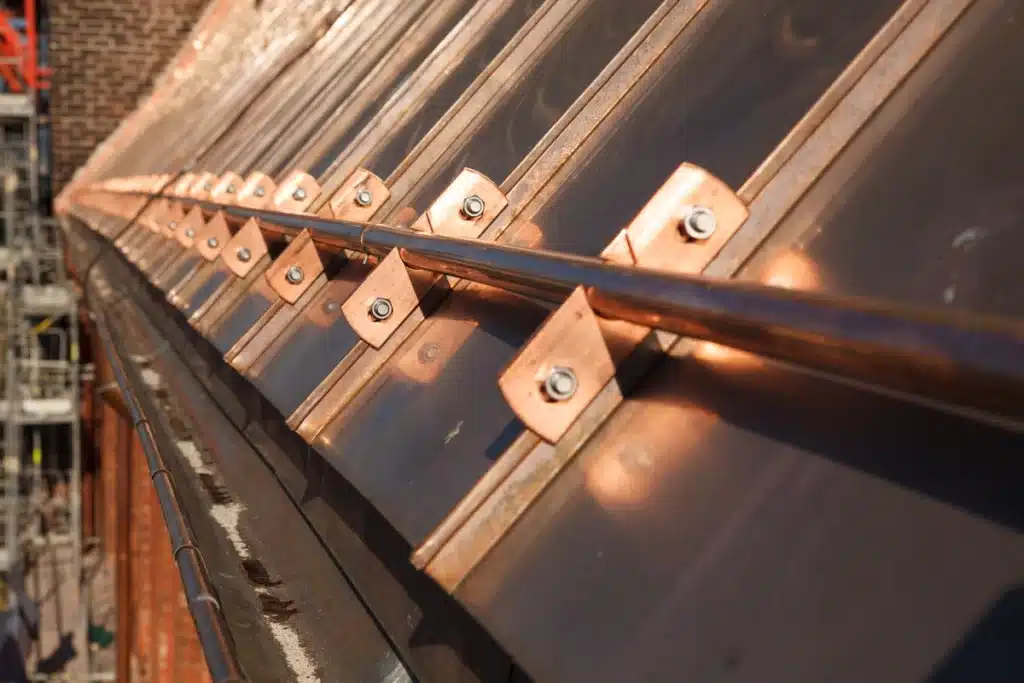Your roof is your home’s most critical component. It’s what keeps you and your family safe, as well as your furnishing and personal belongings from the elements. It also plays a role in keeping the structure of your home from becoming vulnerable. [Roofing 101]
That’s why, as a homeowner, it’s important to understand what your roof is made of and how it works. Consider this your roofing 101 crash course — a basic guide for homeowners that explains:
- The anatomy of a roofing system
- Roofing materials and design elements
Keep reading to learn more about how you can take care of your roofing system. [Roofing 101]
Table of Contents
Roofing 101: The Anatomy of a Roof System

The first thing you need to know about your roof is what lies below the shingles. In other words, its anatomy. The basic roofing components (both structural and design elements) are as follows:
- Roof ridge: The ridge of your roof is the horizontal line that runs the length of the roof, allowing the two slanted planes to meet. This intersection is also the highest point of your roof, often referred to as its peak.
- Ridge vents: A ridge vent is an exhaust vent that also runs horizontally along your roof’s peak. It’s responsible for proper ventilation by allowing warm and humid air to escape from your attic or access space. [Roofing 101]
- Roof flashing: Flashing is the metal material that’s installed at joint openings, such as around chimneys, skylights, and any dormer windows you may have. Flashing is what prevents water intrusion by providing a location for water to run to and run down and away from your roof when it rains.
- Hip: The hip on your roof is the intersection where two slanted planes meet. More specifically, this is where they form a sloping ridge that runs from the peak of your roof to its eave.
- Roof deck: The roof deck is the structural foundation that provides a base for your roofing system and is typically made from wood or plywood.
- Underlayment: Roofing underlayment is a layer of material, usually felt or synthetic fibers that serves as extra protection for your roof deck. It’s installed in between the roof deck and shingles and works to further repel moisture and prevent water from seeping through.
- Roof valley: Your roof valley is the v-shaped intersection between two sloping roofs that join at an angle to encourage water runoff.
- Roof gable: The roof gable is the triangular section of the outer wall that occurs at the peak of your roof between its slopes and eaves. It’s also sometimes referred to as a rake.
- Metal drip edge: The metal drip edge is the narrow strip of metal that’s installed at the gables and eaves. It’s noncorrosive and is designed to help manage dripping water by encouraging water runoff to protect the underlying section of the wall it hangs over.
- Dormer: Dormers are the raised sections of your roof. They’re commonly accompanied by a window that vertically projects through the slopes throughout your roofing system.
- Ice and water barrier: An ice and water barrier serves as a self-adhered waterproofing material. It’s installed along the eaves, valleys, side walls, and other vulnerable areas to help protect against ice damage and rain pushed horizontally by heavy winds.
- Eave: Eaves are the lower border of the roof that slightly hangs over the outer wall of your home. You can find them in the first three feet of your roofing system.
- Undereave vent: Undereave vents are the intake vents located beneath the eaves of your roofing system. They’re responsible for drawing in cool, dry air into your attic or access space.
- Shingles: Shingles are the outermost layer of your roofing system. There are several different types of shingles and different materials that can be used to make them, but asphalt shingles are the most common. They serve to protect your roofing system as well as add to the aesthetic of your home.
- Rafters: Rafters are the wood or metal slats installed inside of your attic. They’re designed to support your roof deck, and you can think of them as the skeleton of your roofing system. [Roofing 101]
5 Standard Roofing Material Options
There is a wide variety of roofing materials you can choose from. As mentioned above, asphalt shingles are the most common. Here’s an overview of the most common roofing materials:
1) Asphalt Shingles
Asphalt shingles are made from asphalt or a composite mixture, and they mimic the appearance of slate. Asphalt shingles range from architectural shingles to 3-tab shingles to offer homeowners a variety in dimension and style.
2) Metal Roofing
Metal roofing is becoming more popular among homeowners as metal roofing systems can last up to 70 years and are considered sustainable. Metal roofing is typically made from copper, aluminum, steel, and galvanized metal amalgams that are coated for corrosion resistance.
3) Slate
Slate is considered a traditional material as well as a premium material. Slate roofing made from clay and volcanic ash, and it’s one of the most durable roofing materials on the market. It’s also long-lasting (up to 100 years) and completely fire-resistant. [Roofing 101]
4) Tile

Tile roofing can be made from clay (traditional) or contemporary materials, such as thermoplastics. Tile roofing is also long-lasting, and regardless of the actual material, they offer a mediterranean aesthetic with its terracotta look. [Roofing 101]
5) Wood Shingles or Shakes
Wood shingles and shakes are typically made from cedar, spruce, or treated pine. Wood shingles and shakes are installed as tapered slabs, similar to asphalt shingles. They offer a rustic aesthetic and are naturally weather resistant. However, they require more maintenance compared to the other types of materials. [Roofing 101]
There’s More to Learn About Your Roofing System

Roofing 101 doesn’t end here as there’s plenty that homeowners should know about their roofing systems. This would include roof maintenance, identifying roof damage, what to do when there’s storm damage, how to file a homeowners insurance claim and much more. [Roofing 101]
If you’re curious to learn more about roofing systems, you can check out Tectum Roofing’s blog. You can also call us with any questions or to schedule a free roof inspection if you suspect there’s damage.


